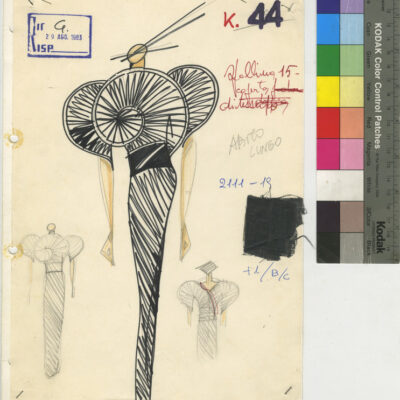
EFHA World 26.03.2023
26.03.2023
fashion archiveItalian fashionstilismo
A closer look at the ‘inventor’ of Italian stilismo through the collection of sketches and documents held at CSAC
The transition from Florence, the cradle of the imagination linked to the artisan tradition, to Milan, a city in full industrial ferment, sanctions the affirmation of Italian prêt-à-porter by prefiguring the international success of stylism. Walter Albini is the proponent of this change when, on October 17, 1971, he presents the unitary F/W 1971-72 collection in the Sala d’Oro of the Circolo del Giardino in Milan, preferring this venue to the historic Sala Bianca of Palazzo Pitti in Florence.
The goal is to reach a heterogeneous public with different desires, needs and economic possibilities. Albini uses Jugend suggestions in the collection, alternating with geometric motifs of Viennese origin, together with a clear reference to the déco culture. The designer designs exclusively for five different fashion houses that make use of the Ferrante Tositti Monti (FTM) group for product distribution. The five companies are Escargots specialized in knitwear, Basile in men’s suits, coats, raincoats and suits, Diamant’s active in the shirt sector, Callaghan specialized in the production of jersey coordinates and Misterfox in cocktail and evening dresses. The unified design of five collections differing by clothing genre and client is a great novelty for the stylistic panorama of the seventies. The fashion show, in turn, is defined according to a succession of models that are presented in relation to the various phases of the day: daywear, ‘house’ or ‘office’ dresses followed by cocktail dresses or ‘elegant afternoon’ and finally from evening dresses. The design drawings are characterized by the presence of fabric samples, stylistic indications and sketches of details of the look, from jewels to brooches, together with details of the model. The drawing of the female figure can be ascribed to the tradition of the French fashion sketch of the 1920s, in terms of gestures and attitude. The silhouette is elongated and non-naturalistic and the drawing is always made first in pencil and then marked with an ink mark. The knitwear is colored in shades of beige, ochre, brown, dark green and orange organized within geometric structures. The yarns are original English shetland Ballantyne (from the San Maurizio spinning mill), Bertrand cashmere, Merinangora lambswool, angora from the Chiavasse spinning mill and Rayon from Snia.
The day suits are a tribute to the creations of Chanel. Ample space is given to carefully selected accessories: hats by Borsalino, gloves by Trussardi, footwear by Fratelli Rossetti (for men) and Italo Colombo (for women), buckles and jewel brooches designed by Ugo Correani and Gianfranco Ferré. The runway make-up is by Helena Rubinstein. Cocktail and evening dresses are influenced by American cinema; they have a flared line, are loose or draped, and stopped at the waist by sashes.